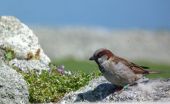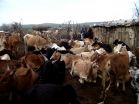(Press-News.org) Fast Facts:
Medicine-loaded nanoparticles show promise for humans needing corneal transplants.
Tiny nanoparticles may be solution for medicine compliance.
Animal study gives patients, family members and clinicians hope for more easily managing medicine after eye surgery.
There are about 48,000 corneal transplants done each year in the U.S., compared to approximately 16,000 kidney transplants and 2,100 heart transplants [1] [2]. Out of the 48,000 corneal transplants done, 10 percent of them end up in rejection, largely due to poor medication compliance. This costs the health care system and puts undue strain on clinicians, patients and their families.
Johns Hopkins Medicine researchers may have discovered a way to prevent rejection by using biodegradable nanoparticles that release needed medication into the eye after surgery. This discovery could solve the decades-old issue of medicine compliance and help patients achieve corneal transplant success.
"Medicine compliance is a major challenge in patient care," says Walter Stark, M.D., chief of the Division of Cornea, Cataract and External Eye Diseases at Johns Hopkins. "About 60 to 80 percent of patients don't take medicine the way they are supposed to."
In an animal study being published in the March 10 issue of the Journal of Controlled Release, researchers looked into ways to alleviate the strain of adhering to a post-surgery treatment regimen that is sometimes hard to manage.
Rats that underwent a corneal graft surgery were randomly divided into four groups and were given various treatments. One group was injected weekly for nine weeks with a safe, biodegradable nanoparticle loaded with corticosteroids for timed release of medicine. The other three groups received weekly injections of saline, placebo nanoparticles and free dexamethasone sodium phosphate aqueous solution after surgery, respectively.
Treatments were given until the graft was clinically deemed as failed or until the nine-week test period concluded. Researchers looked at corneal transparency, swelling and growth of new blood vessels to decide if a graft had failed. For rats that received the nanoparticle loaded with corticosteroids, 65 percent of the treatment remained in the eye and did not leak within one week of the surgery. The concentration of the treatment also remained stronger than in the other three treatment groups. Additionally, there were no signs of swelling, and the cornea was clear throughout the test period. There were also far fewer instances of unwanted growth of new blood vessels in this group.
Two weeks after surgery, rats that received the placebo nanoparticle and saline injections had severe swelling, opaque corneas and unwanted growth of new blood vessels, all indicating graft failure. After four weeks, rats that received free dexamethasone sodium phosphate aqueous solution all had graft failure as well. The only group that showed successful corneal transplant was the group of rats that received the corticosteroid-loaded nanoparticle injections. The grafts were still viable in 100 percent of these rats.
"Corneal grafts are not easy to come by, and a lot of testing and time goes into ensuring the safe use of a graft for cornea transplant," says Qingguo Xu, Ph.D., a research associate at the Center for Nanomedicine at the Wilmer Eye Institute at Johns Hopkins Medicine. "This is why we want to do a better job at making sure corneal transplants don't end up in rejection, and our study illustrates a potentially better way."
The steroid-loaded nanoparticle treatment group showed no signs of corneal transplant rejection. "That's 100 percent efficacy, a very promising finding," says Justin Hanes, Ph.D., director of the Center for Nanomedicine. "This type of treatment may also help prevent corneal transplant rejection in humans while making medicine adherence much easier on patients and their families."
The nanoparticle loaded with medication could eliminate the need for a patient to remember to take their medicine - often multiple doses per hour - after a surgery, alleviating compliance risk. These types of drug delivery systems could be paired with other drugs and used in other conditions, such as glaucoma, macular degeneration and corneal ulcers, among others. The research team intends to continue the collaboration between engineering and medicine to look further into better ways to treat eye diseases.
INFORMATION:
Additional authors include Qing Pan, Nicholas J. Boylan, Nicholas W. Lamb, David Emmert, Jeh-Chang Yang, Li Tang, Tom Feflin, Saeed Alwadani and Charles G Eberhart.
Funding of this study came from the Raymond Kwok Family Research Fund. This work was also partially funded by a grant from the King Khaled Eye Specialist Hospital of Saudi Arabia and the Eye Bank Association of America/Richard Lindstrom Research Grant 2012.
[1] National Kidney Foundation website: https://www.kidney.org/news/newsroom/factsheets/Organ-Donation-and-Transplantation-Stats
[2] U.S. Department of Health and Human Services Organ Transplantation Network website: http://optn.transplant.hrsa.gov/converge/latestData/rptData.asp
Media Contact: Marin Hedin, 410-502-9429, mhedin2@jhmi.edu
Helen Jones, 410-502-9422, hjones49@jhmi.edu
More than 300 years ago, three African-born slaves died on the Caribbean island of Saint Martin. No written records memorialized their fate, and their names and precise ethnic background remained a mystery. For centuries, their skeletons were subjected to the hot, wet weather of the tropical island until they were unearthed in 2010 during a construction project in the Zoutsteeg area of the capital city of Philipsburg.
Now researchers at the Stanford University School of Medicine and the University of Copenhagen have extracted and sequenced tiny bits of DNA remaining ...
Caltech scientists, inspired by a chemical process found in leaves, have developed an electrically conductive film that could help pave the way for devices capable of harnessing sunlight to split water into hydrogen fuel.
When applied to semiconducting materials such as silicon, the nickel oxide film prevents rust buildup and facilitates an important chemical process in the solar-driven production of fuels such as methane or hydrogen.
"We have developed a new type of protective coating that enables a key process in the solar-driven production of fuels to be performed ...
People of differing competence tend to give each other's views equal weight, preventing them from making the best group decisions, finds new UCL-led research.
This suggests that people with similar levels of competence make the best decision-making groups, as otherwise the tendency to assume equal competence can give undue weight to the opinions of less capable members.
The new study, published in Proceedings of the National Academy of Sciences, investigated how pairs of people with differing competence weighted their own judgements against each other's.
Researchers ...
This news release is available in German.
Reproduction at old age involves risks that may impact one's own life and may impose reduced biological fitness on the offspring. Such evidence, previously obtained in humans and other taxa under laboratory conditions, has now been confirmed by researchers from the Max Planck Institute for Ornithology in Seewiesen together with colleagues from the UK and New Zealand for the first time in free-living animals. In a long-term study on a population of house sparrows they found that offspring of older parents themselves produced ...
Nearly three out of four Chinese adults have poor cardiovascular health, with poor diet and growing rates of obesity compounding the risks associated with continuing high rates of smoking, according to a new survey published in the Journal of the American College of Cardiology.
The 2010 China Noncommunicable Disease Surveillance Group collected cardiovascular health data from a nationally representative sample of more than 96,000 men and women in the general Chinese population. According to estimates derived from the survey results, just 0.2 percent of Chinese men and ...
People in a society are bound together by a set of connections - a social network. Cooperation between people in the network is essential for societies to prosper, and the question of what drives the emergence and sustainability of cooperation is a fundamental one.
What we know about other people in a network informs how much we are willing to cooperate with them. By conducting a series of online experiments, researchers explored how two key areas of network knowledge effect cooperation in decision-making: what we know about the reputation and social connections of those ...
A new study suggests that increases in atmospheric CO2 could intensify extreme droughts in tropical and subtropical regions -- such as Australia, the southwest and central United States, and southern Amazonia -- at much a faster rate than previously anticipated, explains University of Texas at Austin professor Rong Fu in a commentary in the March 9 edition of Proceedings of the National Academy of Sciences.
Fu, a professor at the university's Jackson School of Geosciences, writes about a new study by William K.M. Lau of the University of Maryland and Kyu-Myong Kim of the ...
Once green, the Sahara expanded 5,500 years ago, leading ancient herders to follow the rain and grasslands south to eastern Africa. But about 2,000 years ago, their southward migration stalled out, stopped in its tracks, archaeologists presumed, by tsetse-infested bush and disease.
As the theory goes, the tiny tsetse fly altered the course of history, stopping the spread of domesticated animal herding with a bite that carries sleeping sickness and nagana, diseases often fatal for the herder and the herded.
Now, isotopic research on animal remains from a nearly 2,000-year-old ...
Despite extensive historical knowledge about the African slave trade - including trends in the volume and demographics of the roughly 12 million people shipped from West and West Central Africa to the New World between 1500 and 1850 - fundamental details about their ethnic and geographical origins remain elusive. Dr. Hannes Schroeder from the Centre for GeoGenetics at the Natural History Museum, University of Copenhagen, who led the study, explains:
- There are historical records - merchant ledgers, shipping records and the like - but they tend to refer to coastal shipping ...
In the ongoing Ebola outbreak in West Africa, whose death toll is approaching 10,000, little information has been available about how the human immune response unfolds after infection.
Researchers from Emory and the Centers for Disease Control and Prevention have now obtained a first look at the immune responses in four Ebola virus disease survivors who received care at Emory University Hospital in 2014, by closely examining their T cells and B cells during the acute phase of the disease. The findings reveal surprisingly high levels of immune activation, and have implications ...

